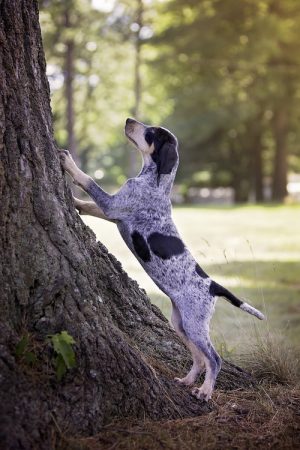
The diversity of the people who settled in different American colonies was reflected in the dogs they brought with them: Scottish, Irish, and German immigrants brought their native hunting dogs with them to areas of the Carolinas, the Appalachian Mountains, and Pennsylvania, while the upper crust of English society put down roots in the southernmost colonies of Maryland,Virginia, and Georgia with their foxhounds. A large blue spotted hunting dog called the Grand Bleu de Gascogne was brought by the settlers to French Louisiana.
Hunting in America turned out to be quite different than what these people knew in the Old Country, and this was especially true in the mountains and swampy regions. Bearing this in mind when mating their dogs, hunters “tweaked” the breedings to develop dogs that could handle these new conditions. The Grand Bleu de Gascogne became an important ingredient in the ancestry of several hounds, and many experts believe that when “blended” with Foxhounds and other coonhounds, the Bluetick Coonhound was the result. In many ways, the Bluetick Coonhound hunts more like a Grand Bleu de Gascogne than an American Fox Hound, and certainly a striking coat resembling a “union suit” of blue ticking is inherited from the Grand Bleu de Gascoigne.
While the Bluetick Coonhound was long recognized as a unique type, the dogs were referred to as English Coonhounds for years. Bluetick breeders were pleased with their cold-nosed, determined and methodical hounds, and didn’t want a hot-nosed, lightening fast hunter that seemed to be the direction in which other breeders were going. They broke ranks with English breeders in 1945, and re-named their dogs the Bluetick Coonhound.
